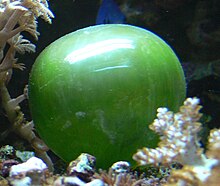Enocelični organizem

Ênocélični organízem ali ênocéličar, tudi úniceluláren organízem, je organizem, ki sestoji iz samo ene celice, v nasprotju z večceličnim organizmom, ki sestoji iz več celic. Zgodovinsko so se preprosti enocelični organizmi imenovali monáde.[1]
Enocelični so prokarionti, večina protistov in nekatere glive. Čeprav nekateri od teh organizmov živijo v kolonijah, so še vedno enocelični. Ti organizmi živijo skupaj, vse celice v koloniji pa so enake. Vsaka celica za preživetje izvaja vse življenjske procese. Nasprotno imajo celo najpreprostejši večcelični organizmi celice, ki so za preživetje odvisne druga od druge.
Nekateri organizmi, npr. Dictyostelium discoideum, so deloma eno- in večcelični. Drugi, npr. Myxogastria in Plasmodium, so lahko enocelični in večjedrni.
‘Candidatus Magnetoglobus multicellularis’, soroden deltaproteobakterijam, je večceličen prokariont. Ni niti enoceličen niti kolonija.
Večina enoceličnih organizmov je mikroskopske velikosti in jih zato imenujemo mikroorganizmi. Nekateri enocelični protisti in bakterije pa so makroskopski in vidni s prostim očesom.[2] Taki so npr.:
- Xenophyophorea, praživali iz debla Foraminifera (luknjičarke), so največji poznani; vrsta Syringammina fragilissima doseže premer do 20 centimetrov.[3]
- Nummulite, luknjičarke
- Valonia ventricosa, alga iz razreda Chlorophyceae, lahko doseže premer od 1 do 4 cm.[4][5]
- Acetabularia, alge
- Caulerpa, alge[6]
- Gromia sphaerica, ameba
- Thiomargarita namibiensis je največja znana bakterija; doseže velikost do 0,75 milimetrov.
- Epulopiscium fishelsoni, bakterija.
Sklici
[uredi | uredi kodo]- ↑ Monad, Biology online, pridobljeno 30. junija 2011
- ↑ Max Planck Society Research News Release. Vpogled 21. maja 2009.
- ↑ Researchers Identify Mysterious Life Forms in the Extreme Deep Sea. Arhivirano 2011-10-26 na Wayback Machine. Vpogled 24. oktobra 2011.
- ↑ Bauer, Becky (Oktober 2008). »Gazing Balls in the Sea«. All at Sea. Arhivirano iz prvotnega spletišča dne 17. septembra 2010. Pridobljeno 27. avgusta 2010.
- ↑ Tunnell, John W.; Chávez, Ernesto A.; Withers, Kim (2007). Coral reefs of the southern Gulf of Mexico. Texas A&M University Press. str. 91. ISBN 1-58544-617-3.
- ↑ http://www.wisegeek.com/what-is-the-largest-biological-cell.htm
Text is available under the CC BY-SA 4.0 license; additional terms may apply.
Images, videos and audio are available under their respective licenses.
